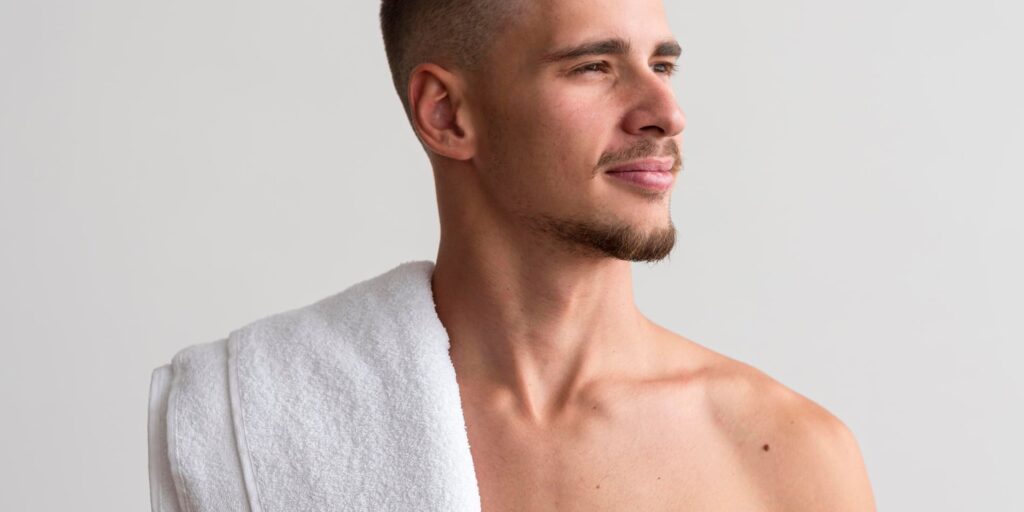Ever wondered if you’re doing manscaping below the belt the right way? Or maybe you’re curious about how to get started? Whether you’re new to the game or just looking to refine your routine, this guide is here to help you navigate the dos and don’ts of grooming down there.
From choosing the right tools to debunking common myths, we’ll cover everything you need to know to keep things tidy, comfortable, and confident. Ready to dive in? Let’s get started!
Why Manscaping Matters
Manscaping below the belt isn’t just about looks—it’s about hygiene, confidence, and showing care for your partner.

Personal Hygiene
- Reduces Sweat and Odor: Less hair means less sweat and odor, keeping you fresher.
- Prevents Bacterial Growth: Trimming reduces the chances of bacteria buildup and irritation.
- Enhances Comfort: Regular grooming can prevent chafing and discomfort.
Aesthetic Appeal
- Boosts Confidence: A well-groomed appearance can make you feel more confident.
- Enhances Definition: Trimming makes everything look tidier and more defined.
- Balances Your Look: Grooming creates a polished, balanced appearance.
Partner Preferences
- Shows Consideration: Manscaping shows you care about your partner’s comfort and preferences.
- Enhances Intimacy: A clean, well-groomed look can make intimate moments more enjoyable.
- Reflects Self-Care: Regular grooming is attractive and signals attention to personal hygiene.
Manscaping below the belt is key to men’s personal hygiene, boosting confidence, and enhancing relationships. With minimal effort, you can feel fresher, look better, and show you care.
The Dos of Manscaping Below The Belt
When it comes to manscaping below the belt, doing it right can make all the difference. Follow these essential dos to ensure a smooth, comfortable, and effective grooming experience.

Use the Right Tools
Choosing the right tools is the first step in any successful manscaping routine. Using improper tools can lead to discomfort, nicks, or less-than-ideal results.
- Electric Trimmer: Ideal for an even trim and managing longer hair.
- Scissors: Great for precise trimming in sensitive areas.
- Body Razors: Choose a quality razor for a close, smooth shave.
Pro Tip: Opt for waterproof, ergonomic tools for easier, more comfortable grooming.
Trim Before Shaving
Before you reach for the razor, it’s smart to trim any longer hairs. This simple step can prevent common issues like irritation and razor burn.
- Why: Trimming reduces hair length, making shaving smoother and less irritating.
- How: Trim hair to about a quarter-inch before shaving.
Pro Tip: Use a trimmer with adjustable settings for better control.
Shave with Care
When it’s time to shave, taking a careful, methodical approach can prevent unwanted cuts and irritation.
- Use Shaving Soap: It softens hair and protects your skin.
- Fresh Blades: A sharp blade reduces nicks and ensures a close shave.
- Shave with the Grain: Follow hair growth to avoid irritation.
Pro Tip: Take your time with short, gentle strokes to prevent cuts.
Moisturize and Soothe
After shaving, your skin needs a little extra care to stay smooth and irritation-free.
- Moisturize: Apply a fragrance-free moisturizer after shaving to hydrate.
- Soothing Balm: Use a Aftershave balm with natural ingredients to reduce irritation.
Pro Tip: Look for products with aloe vera or chamomile for extra soothing.
Keep It Regular
Manscaping isn’t a one-time job—it’s something that requires regular upkeep to keep things looking and feeling great.
- Why: Regular maintenance prevents discomfort and keeps everything neat.
- How Often: Groom every 1-2 weeks, depending on your hair growth.
Pro Tip: Stick to a simple grooming schedule for easy upkeep.
Following these dos ensures that your manscaping below the belt is both effective and comfortable. With the right tools, techniques, and a bit of care, you can enjoy all the benefits of a well-maintained grooming routine.
The Don’ts of Manscaping Below The Belt
While there are plenty of things you should do when manscaping below the belt, there are also some key things to avoid. Here’s what you need to know to steer clear of common mistakes.
Don’t Use Dull Blades
Using an old or dull blade is one of the biggest mistakes you can make when grooming below the belt.
- Why: Dull blades can cause painful nicks and increase the risk of infections.
- Solution: Always use a sharp, fresh razor or maintain your trimmer blades regularly.
Tip: Sharp razors reduce irritation and make grooming safer.
Don’t Rush the Process
Manscaping isn’t something to hurry through. Taking your time can prevent a lot of unnecessary pain.
- Why: Rushing leads to mistakes like cuts and uneven trimming.
- Solution: Take your time and groom carefully for better results.
Tip: Patience ensures careful manscaping with fewer injuries.
Don’t Forget to Exfoliate
Exfoliating before shaving is a step you shouldn’t skip. It helps keep your skin smooth and free of irritations.
- Why: Exfoliation prevents ingrown hairs and keeps skin smooth.
- Solution: Use a gentle exfoliating scrub or washcloth before shaving.
Tip: Choose products designed for sensitive skin to avoid irritation.
Don’t Overdo It
It’s possible to have too much of a good thing. Over-trimming or shaving too frequently can do more harm than good.
- Why: Over-trimming or shaving too often can irritate your skin.
- Solution: Stick to a balanced grooming schedule based on your hair growth.
Tip: Avoiding over-grooming helps prevent irritation and maintains a balanced look.
Don’t Ignore Red Flags
After grooming, it’s important to pay attention to your skin. Ignoring potential issues can lead to bigger problems.
- Why: Signs of infection or persistent irritation need attention.
- Solution: If you notice anything unusual, consult a dermatologist.
Tip: Early detection and dermatologist advice can prevent serious skin issues.
Avoiding these common manscaping mistakes ensures that your manscaping below the belt is both effective and safe.
Common Manscaping Myths Debunked
Let’s clear up some common misconceptions about manscaping below the belt so you can groom with confidence.
Myth 1: “Shaving Makes Hair Grow Back Thicker.”
- Reality: Shaving doesn’t change hair thickness or growth rate. It might feel coarser as it grows back due to the blunt cut, but it’s not actually thicker.
Fact: Hair texture and growth are determined by genetics, not shaving.
Myth 2: “Manscaping Is Just for Aesthetics.”
- Reality: While it enhances appearance, manscaping also improves hygiene by reducing sweat and odor, and preventing irritation. Plus, it boosts confidence.
Myth 3: “Any Razor or Trimmer Will Do.”
- Reality: Using the right tools is essential. Trimmers and razors designed for manscaping are safer and more effective, reducing the risk of nicks and irritation.
Tip: Invest in quality tools made specifically for manscaping below the belt.
Understanding the facts behind these manscaping myths helps you make better grooming choices. With the right knowledge, you can manscape safely and confidently.
Frequently Asked Questions
Here are some quick answers to common questions about manscaping below the belt.
What is Below the Belt Grooming?
- Definition: Trimming, shaving, and maintaining the hair in your pubic area, groin, and surrounding areas.
- Purpose: Enhances hygiene, comfort, and appearance.
Fact: Regular grooming reduces sweat, odor, and skin irritation.
How to Manscape Downstairs for Beginners?
- Start Simple: Use an electric trimmer with a longer guard for your first trim.
- Shave Carefully: If shaving, use a fresh razor and shave with the grain.
- Go Slow: Take your time to avoid nicks and cuts.
Tip: Beginners should start with dry trimming and decide later whether wet or dry shaving suits them.
Should You Manscape Wet or Dry?
- Wet Shaving: Smoother and less irritating, especially with shaving cream.
- Dry Shaving: Quick and convenient with a trimmer but can cause irritation.
Pro Tip: Wet shaving is often better for sensitive skin.
Do Girls Prefer Manscaping?
- Varies: Many partners appreciate it, as it shows care for hygiene and comfort.
- Ask: The best way to know is to communicate with your partner.
Fact: Surveys show that many women prefer men who manscape below the belt.
What is the Best Length for Manscaping?
- Common Length: 1/4 inch to 1/2 inch is often preferred—neat but not too short.
- Personal Choice: Adjust to what feels most comfortable for you.
Tip: Start longer and gradually trim to find your ideal length.
Manscaping below the belt is all about finding what works best for you. Keep it simple, communicate with your partner, and prioritize comfort.
Conclusion
Manscaping below the belt might seem like a small part of your grooming routine, but it can have a big impact on your comfort, hygiene, and confidence. By following the dos and don’ts, debunking common myths, and understanding the basics, you can approach manscaping with ease and confidence.
Key Takeaways:
- Use the Right Tools: Invest in quality trimmers and razors designed for sensitive areas.
- Take Your Time: Rushing leads to mistakes—be patient for the best results.
- Don’t Skip Exfoliation: It helps prevent ingrown hairs and keeps your skin smooth.
- Communicate with Your Partner: Understanding preferences can make grooming a better experience for both of you.
- Find Your Ideal Length: Start longer and trim gradually to discover what feels right.
Fact: Regular grooming isn’t just about looking good—it’s about feeling good too.
By incorporating these tips into your routine, you’ll find that manscaping below the belt is simple and beneficial. Whether you’re doing it for hygiene, aesthetics, or to feel more confident, the key is consistency and care.





